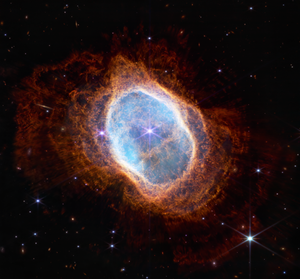NGC 3132 (also known as the Eight-Burst Nebula,[2] the Southern Ring Nebula,[2] or Caldwell 74) is a bright and extensively studied planetary nebula in the constellation Vela. Its distance from Earth is estimated at 613 pc or 2,000 light-years.[2]
| Emission nebula | |
|---|---|
| Planetary nebula | |
 View in near-infrared from NIRCam on the James Webb Space Telescope | |
| Observation data: J2000.0 epoch | |
| Right ascension | 10h 07m 01.7640s[1] |
| Declination | −40° 26′ 11.060″[1] |
| Distance | 2,000[2] ly |
| Apparent magnitude (V) | 9.87[1] |
| Apparent dimensions (V) | 62″ × 43″[3] |
| Constellation | Vela |
| Physical characteristics | |
| Radius | 0.4[2] ly |
| Designations | Eight-Burst Nebula,[2] Southern Ring Nebula,[2] Caldwell 74 |
The Southern Ring Nebula was selected as one of the five cosmic objects observed by the James Webb Space Telescope as part of the release of its first official science images on July 12, 2022.[4]

Planetary nebula nucleus (PNN)
editImages of NGC 3132 reveal two stars close together within the nebulosity, one of 10th magnitude, the other 16th, located about 1.7″ away from the central star. The central star of the planetary nebula is a white dwarf, and is the fainter of the two stars. This hot central star of about 100,000 K has now blown off its outer layers and is making the nebula fluoresce brightly from the emission of its intense ultraviolet radiation.[6] The 16th magnitude star is an A-type main-sequence star of type A2V, and is separated from the white dwarf by at least 1277 au.[7] The A-type star orbits at roughly the same distance as the edge of a dust cloud surrounding the central white dwarf.[7]
See also
editReferences
edit- ^ a b c "NGC 3132". SIMBAD. Centre de données astronomiques de Strasbourg. Retrieved 2007-01-03.
- ^ a b c d e f g "Fast Facts – Planetary Nebula NGC 3132". Hubble Heritage Project. Space Telescope Science Institute. Retrieved 2007-10-06.
- ^ "Results for NGC 3132". NGC/IC Project Database. Archived from the original on 2012-05-20. Retrieved 2011-01-09.
- ^ Garner, Rob (2022-07-08). "NASA Shares List of Cosmic Targets for Webb Telescope's 1st Images". NASA. Retrieved 2022-07-08.
- ^ "Two Views of the Gas in the Southern Ring Nebula (NIRCam and MIRI Composite Images)". October 18, 2023.
- ^ Monreal-Ibero, Ana; Walsh, Jeremy R. (2020). "The MUSE view of the planetary nebula NGC 3132". Astronomy and Astrophysics. 634: A47. arXiv:1912.02847. Bibcode:2020A&A...634A..47M. doi:10.1051/0004-6361/201936845. S2CID 208857629.
- ^ a b Sahai, Raghvendra; Bujarrabal, Valentin; Quintana-Lacaci, Guillermo; Reindl, Nicole; Van De Steene, Griet; Contreras, Carmen Sánchez; Ressler, Michael E. (2023). "The Binary and the Disk: The Beauty is Found within NGC3132 with JWST". The Astrophysical Journal. 943 (2): 110. arXiv:2211.16741. Bibcode:2023ApJ...943..110S. doi:10.3847/1538-4357/aca7ba. S2CID 254096318.
External links
edit- Hubble Heritage Project – Image of NGC 3132
- NGC 3132 on WikiSky: DSS2, SDSS, GALEX, IRAS, Hydrogen α, X-Ray, Astrophoto, Sky Map, Articles and images